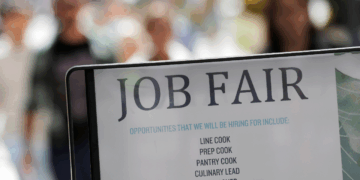- Rather than leaving their positions and remaining in unemployed limbo, professionals are finding jobs elsewhere that meet their newfound expectations of the workplace.
- The Society for Human Resource Management finds that the average cost-per-hire is $4,425, and that figure grows to $14,936 when hiring executives.
- Not only does speeding up the hiring process improve how candidates view a company, but it also helps cut down on the accumulating costs of recruiting, researching, interviewing, and leaving an unfilled role open.
Much has been written about the Great Resignation that has taken the global workforce by storm for the better portion of the last year.
Workers have left their jobs in droves, leaving companies to limit their business and service hours as they struggle with labor shortages.
However, some have argued that this phenomenon could be better described as the Great Reshuffle.
While 47 million workers did indeed quit their jobs in 2021, the biggest takeaway from this massive job exodus is where these workers went.
Rather than leaving their positions and remaining in unemployed limbo, these professionals are finding jobs elsewhere that meet their newfound expectations of the workplace.
Workers have adamantly supported their need for choice, flexibility, as well as a better experience from the interview process and on. Employers that fail to fulfill these demands may fall victim to the Great Resignation, and top talent can find what they need from various forward-thinking firms.
So what does this tell us about current workplace policies and hiring practices?
Why Employees Are Quitting
According to LinkedIn’s February 2022 Workforce, the hiring rate grew by 8.1% in January of 2022 from last December, marking the highest levels seen since the company began tracking this data in 2015.
Additionally, hiring was found to have grown by 10.6% compared to pre-pandemic levels.
This is no surprise: companies are eager to find talent amidst the ongoing labor shortage. But what is driving workers to leave their positions in the first place?
Simply put, it’s an accumulation of dissatisfaction that has been accelerated by the pandemic.
Prior to the outbreak of Covid-19, workplace experts predicted the future of work would be a place that emphasized the importance of flexibility, freedom, and employee wellbeing.
Although these trends were projected to become reality over the course of several years, the pandemic thrust workplace issues into the spotlight.
Pre-pandemic workplace norms included working eight hours a day, five days a week, either in a cubicle or similar traditional office space. However, the last two years have shattered the possibilities of what a workspace can look like.
Employees quickly learned that they could work from the comfort of their homes with little to no loss in productivity. Not only did their work not suffer, but employees gained the ability to achieve a work-life balance for the first time in their professional lives.
Leaders saw the perks, too.
However, as the world begins to loosen their pandemic-related restrictions, companies are once again reconsidering whether to continue with their newfound workplace policies that workers have grown accustomed to.
The combination of skyrocketing consumer demand and the Great Reshuffle has left companies scrambling to find new talent. While some business leaders are hoping that adding new benefits will be enough to attract candidates, simplifying hiring processes may be the easiest first step to bringing in new workers.
The Problem With Modern Hiring Practices
Hiring and recruiting practices are infamously frustrating from both the perspective of employers and prospects.
For starters, finding new talent can be expensive. From utilizing job boards, funding HR departments, adopting hiring software technology, and more, the search for new employees can quickly add up.
In fact, the Society for Human Resource Management finds that the average cost-per-hire is $4,425, and that figure grows to $14,936 when hiring executives.
Not only is this process expensive, but hiring new workers is also time consuming, which can inevitably taint the experience for prospects and lead them to accept a position elsewhere.
However, by speeding up the process, businesses can eliminate the downsides that come with traditional hiring practices.
How Hiring Sprees Can Help Companies Retain Workers
When home improvement retailer Home Depot announced it would be ramping up its hiring process in preparation for the busy spring season, employees learned whether they were hired sometimes within one day.
#theboxthatrocks is Hiring!!!! @SteveSxg704 @dontamcam #powerofthegulf #springvalley Thank you Hortense for being a friendly face and greeter to our customers!!!! pic.twitter.com/yRbjGXMCq5
— Spring Valley Home Depot 6985 (@HomeDepot6985) January 29, 2021
The company also provided new hires with perks such as upskilling opportunities, tuition reimbursement, and more, meaning that benefits and quick hiring do not have to be mutually exclusive.
By quickening the process, leaders send the message that new hires can be onboarded with ease, provided the opportunity to expand their education, and also have room to grow within the company.
Plus, top talent is a hot commodity, and businesses that do not jump at the opportunity to hire on these workers may lose out on the tight competition for quality employees.
With a quick job offer turnaround, employers can expect quicker acceptance rates from candidates, who can then help spread the word of the simple hiring process they just went through.
Not only does speeding up the hiring process improve how prospects view a company, but it also helps cut down on the accumulating costs of recruiting, researching, interviewing, and leaving an unfilled role open.


 Dr. Gleb Tsipursky – The Office Whisperer
Dr. Gleb Tsipursky – The Office Whisperer Nirit Cohen – WorkFutures
Nirit Cohen – WorkFutures Angela Howard – Culture Expert
Angela Howard – Culture Expert Drew Jones – Design & Innovation
Drew Jones – Design & Innovation Jonathan Price – CRE & Flex Expert
Jonathan Price – CRE & Flex Expert













